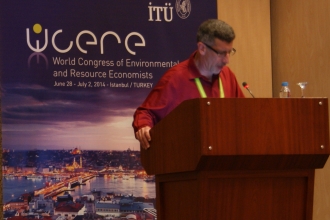
WCERE policy session on forest management reform
The presentations on forest management reform research conducted by EfD in Tanzania, Ethiopia and China addressed major issues such as how effective the reforms are in preventing deforestation and…

The presentations on forest management reform research conducted by EfD in Tanzania, Ethiopia and China addressed major issues such as how effective the reforms are in preventing deforestation and…
This paper investigates how different levels of entrance fees affect donations for a public good, a natural park.
According to advocates, eco-certification can stem environmental damages from tourism in developing countries. Yet we know little about tourism operators’ economic incentives to get certified. To help fill that gap, we use detailed panel data to analyze the Blue Flag beach certification program in Costa Rica where nature-based tourism has caused significant environmental damage. We use new hotel investment to proxy for private benefits, and fixed effects and propensity score matching to control for self-selection bias.
Crafting a set of rules and incentives for the local community in Ostional National Wildlife Refuge (ONWR), one of the few places in the world where sea turtles come ot nest in massive number.
The number of protected areas around the world has significantly increased. However, the effects of this policy on the wellbeing of local households are still under debate. Using pre-treatment characteristics and household surveys with highly disaggregated geographic reference, we explore how national parks affect the wages of local workers in Costa Rica.
Protected areas are a cornerstone of forest conservation in developing countries. Yet we know little about their effects on forest cover change or the socioeconomic status of local communities, and even less about the relationship between these effects. This paper assesses whether “win-win” scenarios are possible—that is, whether protected areas can both stem forest cover change and alleviate poverty. We examine protected areas in the Peruvian Amazon using high-resolution satellite images and household-level survey data for the early 2000s.
Latin America and the Caribbean (LAC) region is exceptionally biodiverse. It contains about half of the world's remaining tropical forests, nearly one-fifth of its coastal habitats, and some of its most productive agricultural and marine areas. But agriculture, fishing and other human activities linked to rapid population and economic growth increasingly threaten that biodiversity. Moreover, poverty, weak regulatory capacity, and limited political will hamper conservation.
We estimate local effects of Payment for Environmental Services (PES) programs on poverty in Costa Rica between 2007 and 2009. Using household surveys and spatial geographic data, we are able to control for socioeconomic and geographic characteristics at the individual and census tract level.
Given the considerable popularity of community-based wildlife management as a conservation tool, it is of interest to assess the long-run sustainability of this policy not only in conservation terms, but also in financial terms. In this paper, we use cost–benefit analysis to study the social and financial sustainability of a large set of community conservancies in Namibia, one of the few countries where community-based wildlife management policies have been in place long enough to assess their long-term viability.
Because the effectiveness of payment for ecosystem services (PES) programs depends on landowners’ engagement, understanding the relationship between the type of payment and participation is a key issue. This paper reports on a choice experiment that quantifies landowners’ preferences for cash and educational in-kind payment. The main results indicate a positive correlation between participation in a PES contract and the magnitude of the cash payment, while participation seems uncorrelated with the magnitude of the educational in-kind payment.